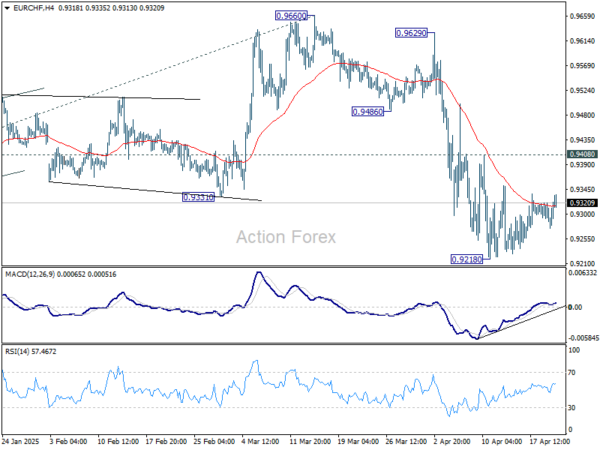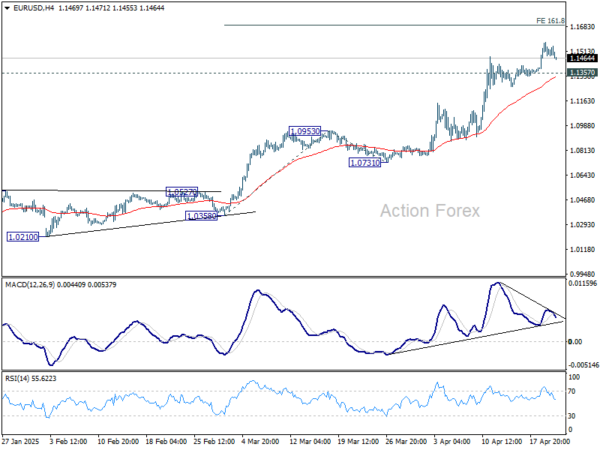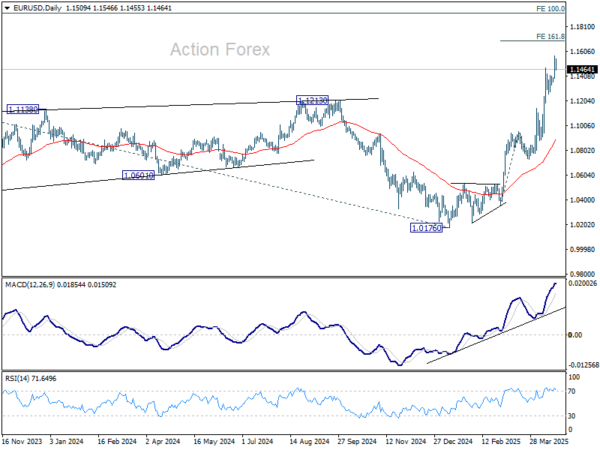Fragile Calm Returns to Markets as Focus Shifts to Fed Remarks – Action Forex
Global markets saw a modest pause in volatility today as risk sentiment stabilized following yesterday’s US selloff. US futures are pointing to a mild recovery, helping to calm nerves in early trading. Meanwhile, US 10-year Treasury yield dipped slightly but remains elevated around 4.4%, reflecting persistent investor caution. Gold also retreated marginally after coming within striking distance of the 3500 mark earlier in the session, as the appetite for safe havens eased slightly.
Despite today’s calm, market sentiment remains on a knife edge. The political backdrop in the US continues to cast a long shadow over financial markets, with fears about Fed’s independence following recent attacks by US President Donald Trump. Any further comments from US officials questioning Fed’s autonomy could quickly reignite volatility. For now, the market is watching closely for signals from a lineup of Fed speakers scheduled for the US session, who are expected to reinforce the central bank’s institutional independence and data-driven approach.
On the trade front, optimism remains scarce. The ongoing 90-day truce on US reciprocal tariffs has so far yielded little tangible progress, with talks reportedly stalling even among close allies like Japan. Uncertainty over what happens when the truce expires continues to weigh on global confidence, limiting the potential for any sustained rebound in risk assets.
In the currency markets, Loonie is underperforming for the week so far, followed by Dollar and Aussie. Yen leads on the stronger side, followed by Kiwi and Euro. Sterling and the Swiss Franc are positioning themselves in the middle of the pack.
Looking ahead, attention will quickly shift to tomorrow’s global flash PMI releases, which will provide a crucial read on business activity, prices and sentiment across major economies. These surveys will be particularly important in gauging the fallout from recent tariff shocks and in setting the tone for monetary policy discussions in the weeks ahead.
Technically, CAD/JPY’s fall from 111.55 is now trying to resume through 101.36 support. The key level to watch is 61.8% projection of 110.45 to 101.36 from 105.85 at 100.23. There is prospect of a bounce from there to complete the five wave sequence from 111.55. However, firm break there should bring downside acceleration to 100% projection at 96.76 next.
In Europe, at the time of writing, FTSE is up 0.27%. DAX is down -0.46%. CAC is down -0.31%. UK 10-year yield is up 0.012 at 4.582. Germany 10-year yield is down -0.014 at 2.459. Earlier in Asia, Nikkei fell -0.17%. Hong Kong HSI rose 0.78%. China Shanghai SSE rose 0.25%. Singapore Strait Times rose 0.96%. Japan 10-year JGB yield rose 0.022 to 1.311.
ECB Survey: Inflation expectations tick higher, growth outlook softens
ECB’s latest Survey of Professional Forecasters for Q2 showed a modest upward revision to inflation expectations, signaling persistent price pressures across the Eurozone.
Headline HICP inflation is now expected to average 2.2% in 2025, before easing to 2.0% in both 2026 and 2027. These figures reflect a 0.1% upward revision for 2025 and 2026. Figures for 2027 was left unchanged.
Core inflation, which excludes energy and food, was also revised slightly higher across all horizons, now projected at 2.3% (prior 2.2%) in 2025 and 2.1% (prior 2.0%) for both 2026 and 2027.
Long-term expectations for headline inflation remain anchored at 2.0%, with core inflation expectations edging up from 1.9% to 2.0%.
On the growth front, the outlook was revised slightly lower for the near term. Real GDP is expected to expand by 0.9% in 2025 and 1.2% in 2026—both down -0.1% from the prior survey—before picking up to 1.4% in 2027. Longer-term growth expectations remain unchanged at 1.3%.
ECB’s Kazimir sees rate near neutral, emphasize flexibility and agility
Slovak ECB Governing Council member Peter Kazimir said in a blog post today that Eurozone inflation is approaching the 2% target and expressed confidence that it will be reached “within the next few months.”
Following the recent rate cut, Kazimir suggested that ECB’s deposit rate at 2.25% is no longer restrictive and could now be considered close to neutral.
Meanwhile, Kazimir cautioned that the economic backdrop remains highly volatile, with uncertainty continuing to dominate the outlook.
“We are operating in a fast-shifting environment,” he said, pointing to escalating global trade tensions linked to US tariff policies as a key source of instability. He warned that this unpredictability “introduced significant ambiguity into the system, eroding confidence.”
Looking ahead to the June meeting, Kazimir emphasized that any decision will depend on incoming data, revised economic forecasts, and a comprehensive risk assessment. His comments reinforce the central bank’s commitment to “flexibility and agility.”
BoE’s Greene: US tariffs more of a disinflationary risk for the UK
BoE Monetary Policy Committee member Megan Greene stated today that the US tariffs pose “more of a disinflationary risk than an inflationary risk” for the UK.
However, she emphasized that domestic factors also remain a concern, particularly the UK’s limited supply capacity, which continues to drive underlying inflationary pressures.
Greene highlighted that this supply-side constraint is a key reason behind her cautious stance on interest rate cuts.
Addressing questions on central bank independence amid political scrutiny of the Fed, Greene emphasized the importance of maintaining institutional credibility.
“Credibility is the currency of central banks,” she said, adding that independence is a critical component of that credibility.
New Zealand posts surprise NZD 970m trade surplus as exports surge 19%
New Zealand recorded stronger-than-expected trade surplus of NZD 970m in March, far exceeding forecasts of NZD 80m. The surprise was driven by a robust 19% yoy increase in goods exports, which rose by NZD 1.2B to NZD 7.6B. Imports also grew, up 12% yoy to NZD 6.6B.
Export performance was particularly strong across key trading partners. Shipments to China rose by NZD 371m (23% yoy), while exports to the US and the EU grew by 22% yoy and 51% yoy respectively. Exports to Japan also increased 11% yoy, although shipments to Australia dipped slightly, down -0.47% yoy.
On the import side, the largest increases came from the US, with a 48% yoy jump worth NZD 243m. This was followed by China and the EU, which posted 14% yoy and 19% yoy gains respectively. Imports from South Korea bucked the trend, falling -12% yoy.
EUR/USD Mid-Day Outlook
Daily Pivots: (S1) 1.1414; (P) 1.1494; (R1) 1.1592; More…
Further rally is expected in EUR/USD as long as 1.1357 support holds. Current rise from 1.0176 should target 161.8% projection of 1.0358 to 1.0953 from 1.0731 at 1.1694 next. Nevertheless, considering bearish divergence condition in 4H MACD, break of 1.1357 should indicate short term topping. Intraday bias will be turned back to the downside for deeper pullback.
In the bigger picture, rise from 0.9534 long term bottom could be correcting the multi-decade downtrend or the start of a long term up trend. In either case, further rise should be seen to 100% projection of 0.9534 to 1.1274 from 1.0176 at 1.1916. This will now remain the favored case as long as 55 W EMA (now at 1.0776) holds.



